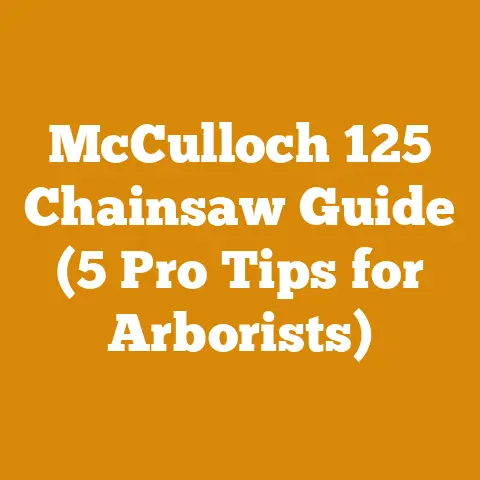Small Log Skidder Selection Tips (7 Expert Arborist Insights)
Ever felt like you were wrestling a giant anaconda every time you tried to move logs around your property? I have. I remember one particularly frustrating afternoon hauling oak logs with a tractor that was clearly designed for mowing lawns, not moving timber. That’s when I knew I needed a better solution. A small log skidder.
Choosing the right skidder can feel like navigating a dense forest of options. That’s why I’ve compiled these seven expert arborist insights to guide you through the selection process, ensuring you pick a machine that’s perfectly suited to your needs and budget. These aren’t just abstract theories; they’re lessons learned from years of experience in the woods. Let’s dive in.
Small Log Skidder Selection Tips (7 Expert Arborist Insights)
1. Assess Your Terrain and Log Size
Before you even start looking at skidders, you need to honestly evaluate your terrain and the typical size of the logs you’ll be moving. Are you dealing with steep hills, muddy ground, or relatively flat, dry land? Are you mostly handling small-diameter firewood logs or larger timber suitable for milling?
I’ve seen firsthand the consequences of mismatching a skidder to the terrain. A lightweight, two-wheel-drive skidder might be fine on level ground with small logs, but put it on a steep slope with large hardwood, and you’ll be spinning your wheels (literally and figuratively).
Terrain Considerations:
- Slope: Steep slopes require more powerful skidders with better traction, often four-wheel-drive models.
- Soil Type: Muddy or sandy soil necessitates wider tires or tracks to prevent sinking.
- Obstacles: Rocks, stumps, and dense undergrowth demand a skidder with high ground clearance and robust protection.
Log Size Considerations:
- Diameter: Larger diameter logs require skidders with higher horsepower and greater towing capacity.
- Length: Longer logs necessitate a longer wheelbase for stability.
- Weight: This is the most critical factor. Estimate the average weight of your logs and choose a skidder with a towing capacity that exceeds that by at least 20% for safety and efficiency. I typically use a timber weight calculator app to get a rough estimate. Remember, green wood is significantly heavier than dry wood.
Actionable Metric: Calculate the average weight of the logs you intend to move. For example, a 12-inch diameter oak log, 10 feet long, weighs approximately 600-700 lbs when green.
Takeaway: Understanding your terrain and log size is the foundation of choosing the right skidder. Don’t skip this crucial step.
2. Consider Skidder Type: Cable vs. Grapple
The two main types of small log skidders are cable skidders and grapple skidders. Each has its advantages and disadvantages, and the best choice depends on your specific needs and operating style.
Cable Skidders:
- How they work: Cable skidders use a winch and cable to pull logs towards the skidder. You manually attach the cable to each log (or a group of logs using chokers).
- Advantages: Generally less expensive than grapple skidders. More versatile for selectively logging in tight spaces, as you can reach logs that are further away or partially obstructed.
- Disadvantages: More labor-intensive, as you need to manually attach and detach the cable. Slower than grapple skidders, especially when moving multiple logs. Higher risk of back injuries if proper lifting techniques aren’t used.
Grapple Skidders:
- How they work: Grapple skidders use a hydraulic grapple to grab and lift logs.
- Advantages: Much faster and more efficient than cable skidders, especially when moving multiple logs. Less labor-intensive. Safer, as you don’t need to manually handle logs as much.
- Disadvantages: More expensive than cable skidders. Less versatile in tight spaces, as the grapple requires more maneuvering room. Can be more damaging to the forest floor, as the grapple can disturb the soil.
Personal Story: I initially started with a cable skidder because it was more affordable. While it got the job done, I quickly realized how much time and energy I was wasting manually attaching and detaching cables. When I switched to a grapple skidder, my productivity increased dramatically.
Original Insight: Consider the long-term cost savings of a grapple skidder. While the initial investment is higher, the increased efficiency and reduced labor costs can quickly offset the difference, especially if you’re logging frequently.
Takeaway: Choose a cable skidder if you prioritize affordability and versatility in tight spaces. Opt for a grapple skidder if you value speed, efficiency, and reduced labor.
3. Horsepower and Towing Capacity: Match the Power to the Load
Horsepower (HP) and towing capacity are two of the most critical specifications to consider when selecting a small log skidder. They determine the skidder’s ability to pull logs effectively and safely.
Horsepower:
- What it is: Horsepower is a measure of the engine’s power output. More horsepower generally means more pulling power.
- How much do you need? For small-scale logging with logs under 16 inches in diameter, a skidder with 40-60 HP may suffice. For larger logs or steeper terrain, consider a skidder with 60-80+ HP.
- Important Note: Don’t solely rely on horsepower. Torque, which is a measure of rotational force, is equally important. A skidder with high torque at low RPMs will be better at pulling heavy loads uphill.
Towing Capacity:
- What it is: Towing capacity is the maximum weight the skidder can safely pull. It’s usually expressed in pounds or tons.
- How much do you need? As mentioned earlier, calculate the average weight of the logs you intend to move and choose a skidder with a towing capacity that exceeds that by at least 20%. This provides a safety margin and prevents overloading the skidder.
- Example: If you’re typically moving logs that weigh 1,000 lbs each, choose a skidder with a towing capacity of at least 1,200 lbs.
Case Study: I once helped a friend who bought a skidder with insufficient horsepower. He was constantly struggling to pull logs up even slight inclines, and the engine was overheating. He ended up having to sell it at a loss and buy a more powerful model.
Actionable Metric: Check the skidder’s specifications for both horsepower and towing capacity. Also, look for reviews or test data that demonstrate its performance in real-world conditions.
Takeaway: Choose a skidder with sufficient horsepower and towing capacity to handle your typical log size and terrain. Err on the side of more power rather than less.
4. Tire Size and Traction: Grip is King
The tires are the skidder’s connection to the ground. The right tire size and tread pattern can make a huge difference in traction, stability, and overall performance, especially in challenging terrain.
Tire Size:
- Wider Tires: Wider tires provide a larger contact area, which improves traction in soft or muddy ground. They also distribute the weight of the skidder and the load more evenly, reducing the risk of sinking.
- Taller Tires: Taller tires increase ground clearance, allowing you to navigate over obstacles more easily.
- Example: A skidder with 28L-26 tires will generally have better traction and flotation than a skidder with 23.1-26 tires.
Tread Pattern:
- Bar Lug Tires: Bar lug tires are the most common type of tire used on skidders. They have aggressive, angled lugs that provide excellent traction in mud, snow, and loose soil.
- Flotation Tires: Flotation tires have a wider, flatter profile and a less aggressive tread pattern. They are designed to “float” over soft ground, minimizing soil disturbance.
- Dual Tires: Some skidders can be equipped with dual tires, which provide even greater traction and stability.
Tire Pressure:
- Adjusting Tire Pressure: Adjusting tire pressure can significantly impact traction and flotation. Lowering tire pressure increases the contact area and improves traction in soft ground. However, lowering tire pressure too much can damage the tires.
- Recommended Pressure: Consult the skidder’s manual for the recommended tire pressure for different operating conditions.
Personal Experience: I learned the importance of tire pressure the hard way. I once got my skidder stuck in a muddy patch because I hadn’t lowered the tire pressure. After letting some air out of the tires, I was able to drive right out.
Actionable Metric: Research different tire options and choose a tire size and tread pattern that are appropriate for your terrain. Consider using tire chains for added traction in icy or snowy conditions.
Takeaway: Invest in high-quality tires that provide adequate traction for your terrain. Experiment with tire pressure to optimize performance.
5. Safety Features: Protect Yourself and Your Investment
Safety should always be your top priority when operating heavy machinery like a log skidder. A skidder equipped with essential safety features can significantly reduce the risk of accidents and injuries.
Rollover Protection Structure (ROPS):
- What it is: A ROPS is a reinforced frame that protects the operator in the event of a rollover. It’s usually a steel cage that surrounds the operator’s seat.
- Importance: A ROPS is an essential safety feature that can save your life in a rollover accident.
- Requirement: Make sure the skidder you choose has a certified ROPS that meets industry standards.
Falling Object Protective Structure (FOPS):
- What it is: A FOPS is a protective structure that protects the operator from falling objects, such as tree limbs.
- Importance: A FOPS is especially important when working in dense forests where falling objects are a common hazard.
- Construction: It is usually constructed of heavy-duty steel mesh or polycarbonate.
Seatbelt:
- Requirement: Always wear your seatbelt when operating a skidder.
- Importance: A seatbelt can prevent you from being thrown from the skidder in a rollover or collision.
Emergency Shut-Off:
- Function: An emergency shut-off allows you to quickly stop the engine in case of an emergency.
- Location: Make sure the emergency shut-off is easily accessible from the operator’s seat.
Lights and Mirrors:
- Importance: Adequate lighting and mirrors are essential for safe operation, especially in low-light conditions.
- Maintenance: Ensure all lights and mirrors are in good working order.
Fire Extinguisher:
- Requirement: Keep a fire extinguisher readily available on the skidder.
- Importance: A fire extinguisher can help you quickly put out a fire, preventing serious damage to the skidder or surrounding forest.
Actionable Metric: Inspect all safety features before each use. Ensure the ROPS and FOPS are in good condition, the seatbelt is functioning properly, and the emergency shut-off is easily accessible.
Takeaway: Prioritize safety when selecting a skidder. Choose a model with essential safety features and always follow safe operating procedures.
6. Maintenance and Repair: Plan for the Long Haul
A log skidder is a significant investment, and proper maintenance is crucial for ensuring its longevity and reliability. Before you buy a skidder, consider the availability of parts and service in your area.
Parts Availability:
- Local Dealers: Choose a skidder brand that has a strong network of local dealers. This will make it easier to obtain parts and service when you need them.
- Online Retailers: Many online retailers sell skidder parts, but be sure to choose reputable sources.
- Used Parts: Consider purchasing used parts to save money, but inspect them carefully before buying.
Service Availability:
- Qualified Mechanics: Find a qualified mechanic who is experienced in working on skidders.
- Preventive Maintenance: Establish a preventive maintenance schedule and stick to it. This will help you catch potential problems early and prevent costly repairs.
- DIY Repairs: If you’re mechanically inclined, you can perform some repairs yourself. However, be sure to follow the manufacturer’s instructions and use the correct tools.
Maintenance Schedule:
- Daily: Check fluid levels (oil, coolant, hydraulic fluid), inspect tires, and lubricate grease fittings.
- Weekly: Check air filter, fuel filter, and hydraulic filter.
- Monthly: Change oil and filters, inspect belts and hoses, and check brakes.
- Annually: Perform a thorough inspection of all systems and components.
Original Insight: Consider the total cost of ownership, not just the purchase price. A cheaper skidder that requires frequent repairs can end up costing you more in the long run.
Actionable Metric: Research the availability of parts and service for different skidder brands in your area. Ask other loggers for recommendations.
Takeaway: Choose a skidder that is relatively easy to maintain and repair. Establish a preventive maintenance schedule and stick to it.
7. Budget and Financing: Smart Spending Strategies
Buying a log skidder is a significant investment, so it’s essential to establish a budget and explore financing options.
New vs. Used:
- New Skidders: New skidders offer the latest technology, warranty coverage, and lower maintenance costs (at least initially). However, they are more expensive.
- Used Skidders: Used skidders can be a more affordable option, but they may require more maintenance and have a shorter lifespan.
- Inspection: If you’re considering a used skidder, have it inspected by a qualified mechanic before you buy it.
Financing Options:
- Loans: Many banks and credit unions offer loans for equipment purchases.
- Leasing: Leasing can be a good option if you don’t want to tie up a lot of capital.
- Government Programs: Some government programs offer grants or loans for small businesses in the forestry industry.
Negotiating Price:
- Research: Research the market value of the skidder you’re interested in.
- Be Prepared to Walk Away: Don’t be afraid to walk away from a deal if you’re not comfortable with the price.
- Consider Package Deals: Some dealers offer package deals that include attachments or other equipment.
Personal Experience: I once saved a significant amount of money by purchasing a used skidder at auction. However, I had it thoroughly inspected beforehand and factored in the cost of some necessary repairs.
Actionable Metric: Get quotes from multiple dealers and compare financing options. Consider the long-term cost of ownership, including maintenance, repairs, and fuel.
Takeaway: Establish a realistic budget and explore financing options. Don’t be afraid to negotiate the price.
By carefully considering these seven expert arborist insights, you can confidently choose a small log skidder that meets your specific needs and budget, transforming those frustrating log-moving days into efficient and productive operations. Remember, the right tool makes all the difference!






